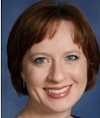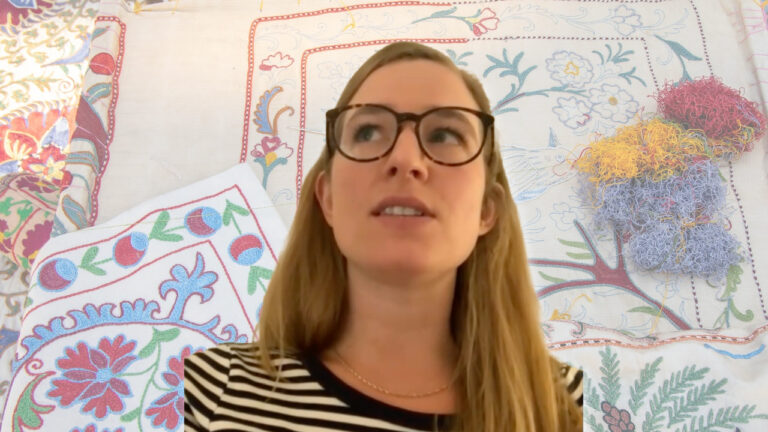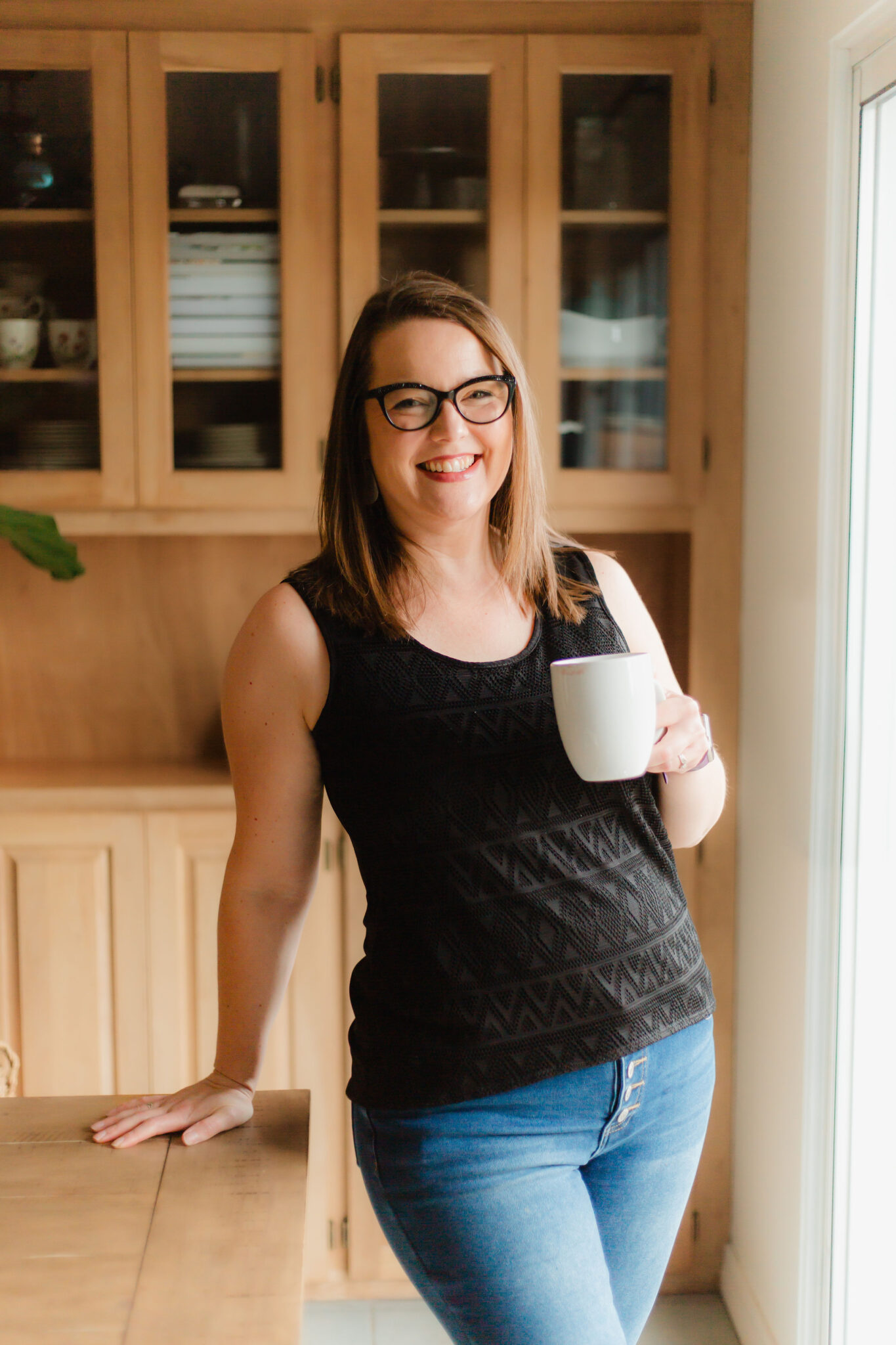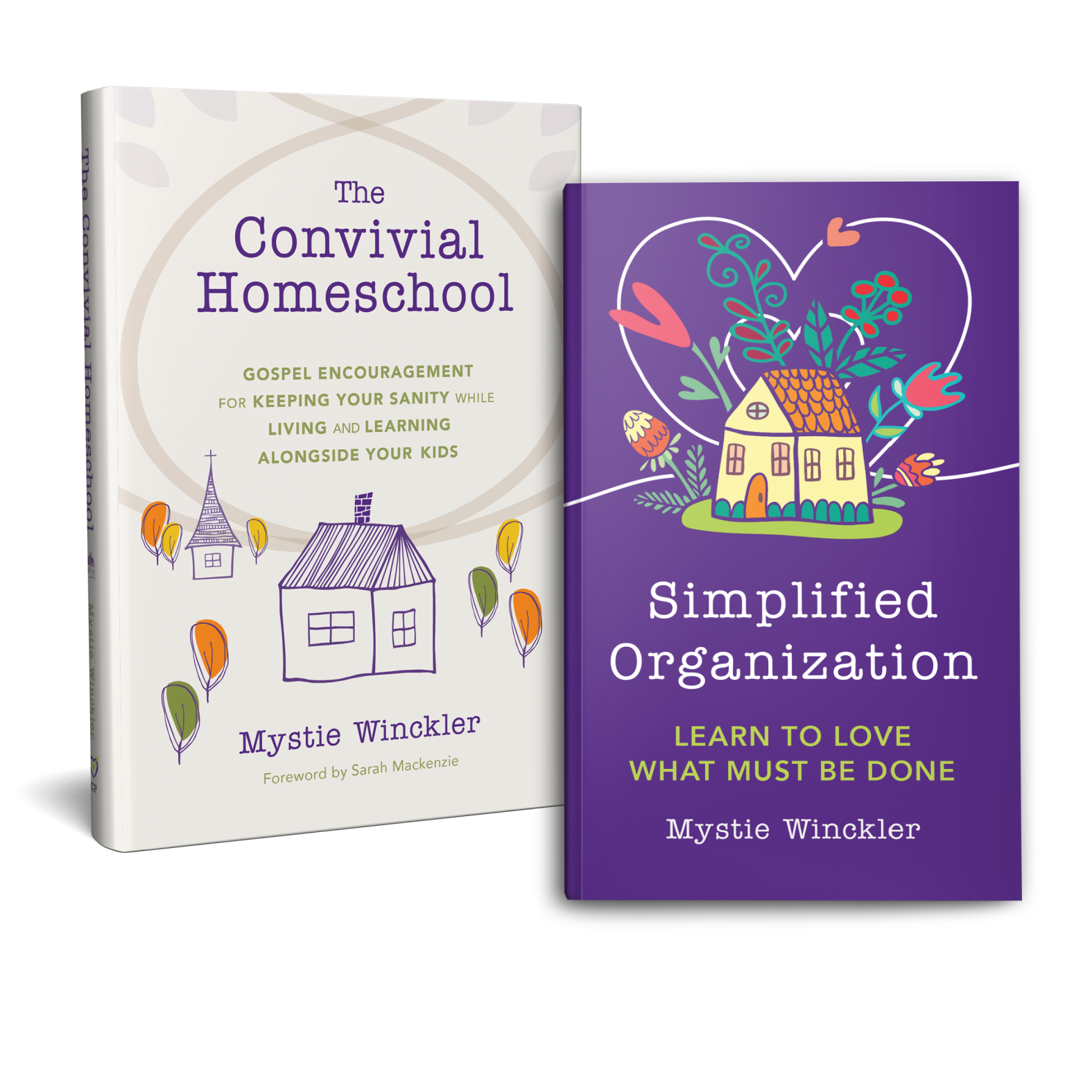Yes, you can love being a homemaker.
Despite sinks full of dishes, hampers piled with laundry, crumbs on the floor, and children wanting to eat again – You can enjoy your life as a mom without giving in to perfectionism or overwhelm.
Mystie
Winckler
Homemaker & homeschool mom for 20+ years
Hi! My husband and I are both second-generation homeschoolers who now have two homeschool graduates and three still at home being educated. When we got married at 19, I assumed homemaking would be easy – just cook, clean up, and have plenty of time left over to read.
Not so. Homemaking – and homeschooling and mothering – have been God’s path of humility and sanctification for me. Now, I wouldn’t have it any other way. Let me share not only what I know now, but also how to walk the path of sanctification at home.
OVERWHELMED? TRY MY
brain dump guide to declutter your head
Messy house got you down?
For the mom who is discouraged that the chores are never done –
For the mom who has tried so many routines, but nothing has stuck –
For the mom who thought she’d have her life together by now –
You can keep up with life without being overwhelmed.
Find help inside Convivial Circle, my homemaking discipleship and support group for moms.

“Simply Convivial has made a big difference for me in figuring out how to implement routines that work for ME and my house and my energy level. Much appreciated!”
AMBERLEY ALMARODE
Sweet Notes
from inside Convivial Circle
Established in 2018, our membership community has over 600 women, 12 courses, accountability, Zoom calls, weekly live sessions, and a vault of replays on every homemaking topic.
600 +
LIKEMINDED WOMEN INSIDE
Now I choose progress over perfectionism.
Becoming more organized with all aspects of life and iterating on my organizing has helped me fight perfectionism. My new habits help me pull life together and realistically frame my expectations each day. I’m so thankful for all you do to minister to homemakers!
Rachel Bozarth
Because of Convivial Circle, I am more realistic.
My brain feels less cluttered, and I no longer get overwhelmed. I’m quicker to rebound from bad days, and overall I have more emotional energy for life.
Amanda Sewell
I was really struggling with overcommitting.
I said “Yes” to too many things out of the house and online, and it was affecting my family and my marriage. The module on REST was huge for me. Now I look at my homemaking duties with a thankful heart instead of grumbling.
Ashley Weaver
READ more
Latest from the blog

What is a reasonably clean home? (and how to get one)
We don’t want to be the nagging, harping mom. But, it happens. What other options are there when the kids won’t keep their stuff picked up? We’re working so hard for a more clean and…

Want a clean home? Do this for efficient routines.
How many times have you scoured the internet, browsed Pinterest, or binged YouTube, looking for the next best tip or secret for a clean home? You want a clean home, fast, but no tips seem…

Can moms have hobbies?! – an interview with Lexy Sauvé
Or, being a creative homemaker It’s so easy to feel worn down and exhausted by life, mothering, and all the things – especially when you have six kids like Lexy Sauvé. Lexy has learned a…

On busy schedules and discipling our kids – with Hannah Spuler
When life gets busy, when kids and their activities multiply, it can be easy to assume something is terribly wrong and we need to cut back until we feel like we can handle it all….

Live the life of lifelong learning
Lifelong learning is not just for our kids. The connections and big ideas in our kids’ lessons can become our own.

Education is about connections
When live wires connect, electricity flows. When roots connect to moist soil, nutrients are sent up so the plant can grow. When magnets connect, they can hold up an astonishing amount of weight. What happens…

Enjoying seasons of motherhood – an interview with Lindsey Stomberg
Or, working with what you’ve got – It’s hard to keep track of how fast life, seasons, and stages pass when you’re managing a large family, homeschooling, and ministry. Lindsey runs the Reformed Faith and…

The Right Kind of Service Mindset for Moms
Life is complicated. Families are complicated. Nothing runs on autopilot – not us, not meals, not laundry, not housework, not schoolwork. Someone has to be responsible, managing all the moving parts so that an unlikely…

Finding Joy in Motherhood – an interview with Jami Balmet
Jami Balmet is a Christian homemaker, wife, and mother with not just 7 kids, but 2 sets of twins, so she knows a whole new level of mothering intensity. In this interview, she shares the…

Planning without wasting time
I have spent hundreds of dollars on planners. Large boxes, full of every conceivable office supply product, sat in my closet. I have spent hours – perhaps hours totaling days – setting up apps to…

A weekly planning dashboard that works – hot tips from real moms
Why we need weekly dashboards Do you ever feel like you aren’t gaining the traction you’d like to with your planning efforts? I totally relate. I think we’ve all experienced the confusion and frustration of…

Time Management for Moms
There really is no such thing as time management. There’s only self-management. You don’t use your time better and end up with more. Usually it seems less time because of how we spent it, though…

Facebook is not forever
Or, what we really want out of social media Although Americans want to believe it, and manipulate to contrive it, there actually is no such thing as “too big to fail.” History shows us rather…

Time management for new moms
Time management is hard. Books and YouTube videos abound with all manner of tips, tricks, and systems. You can make an Ideal Week with Michael Hyatt, time block with Cal Newport, or manage your calendar…

Managing Mom-Life with ADHD, an interview with Ashley Weaver
We all have so much to do that it’s hard to stay focused. In addition to hefty to-do lists, there are the million-and-one things vying for our attention and trying to get in front of…







